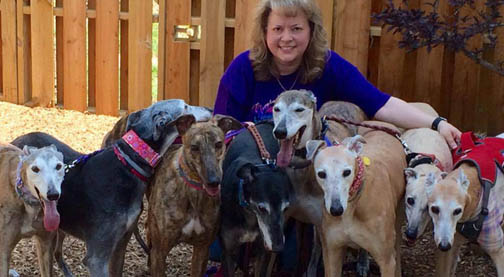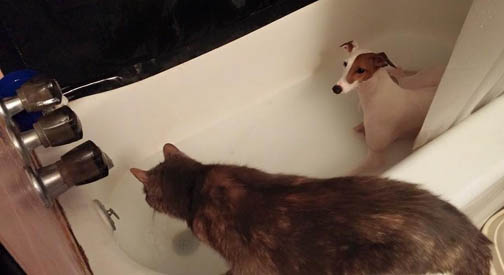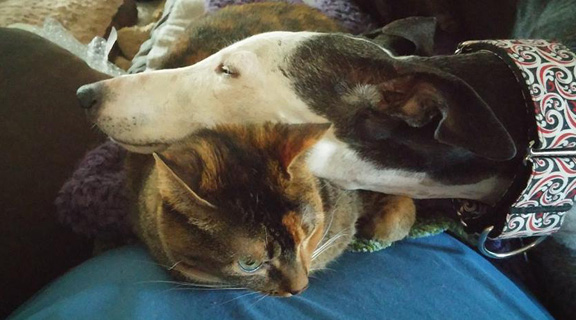I’ve often been asked why I adopt and love senior Sighthounds so much. There’s a good reason I get that question. I do have two youngsters -- Cole, age 5 and Penny, age 4. But I have half a dozen oldies:
Sarah, age 13
Eve, age 12 (retired brood mama)
Silver, age 10 (retired stud dog)
Marina and Eris, two 10-year-old littermates
Sally, Eve’s daughter, age 9
All are Greyhounds. To round out the pack, we also have 3 senior Italian Greyhounds and a 13-year-old beagle/basset mix who thinks he’s a Sighthound.
So here’s my answer: I love seniors so much because they give me way more than I could ever give them. And they’ve taught me so much about strength, determination, and the will to live in the face of adversity.

When I adopted our first brood mama, I thought that she was a “senior” at the ripe old age of eight. (Most vets will consider a dog a senior between seven and 10.) Since then I’ve realized that Eve was really just middle-aged as far as Greyhounds go. It’s possible for our sighthounds to live much longer than we might think -- with the proper assistance from us.
The key is to be flexible, be willing to go that little extra mile and, most importantly, to be observant and know what’s normal (and not normal) for your dog. Coming up with a well-rounded plan can go a long way to help your senior stay happy, comfortable, and secure as they age.
Of course, senior pups need to have regular vet visits and you need to have a good relationship with your vet. If your senior either has an existing medical condition or is over the age of 10 or 11, I recommend twice-a-year vet visits. This will help you keep a check on their weight and also get the vet’s opinion on things like their teeth, eyes, feet, and any current lumps and bumps. Your vet will typically recommend regular blood work for seniors, sometimes called a senior panel, and you may even be offered a discount for doing blood work, urinalysis, and a fecal check all at the same time.
“Senior-hood” is also the time to start discussing necessary versus un-necessary vaccinations with your vet. As our pets become elderly, it’s often more harmful for them to have what some consider “optional” vaccinations. There’s lots of new information available weighing the risks versus the benefits. You may also want to consider taking your senior to a chiropractor or a vet who does acupuncture and/or Chinese herbs if they’re having any type of issue such as joint pain or back or hip problems.
Just as important as your relationship with the vet, senior pups have special needs related to two main areas: food and supplements, and mobility assistance.
Food and Supplements
While it’s not necessary for a senior dog to be on what’s considered a “senior” food, it is important that the food be of good quality. But it also cannot be too rich for their digestive system. Some seniors don’t handle high protein foods well, particularly if their kidneys aren’t working like they used to.
Remember that as your hounds age, their senses of smell and taste can decline, so it’s important to feed them a food that they’ll enjoy. If needed, don’t hesitate to change it up for them. A change in food may be just what they need! Dogs with kidney disease are notorious for losing their appetite so it might be a bit more challenging to tempt them to eat. Satin balls (see below) can help. But if you’re still finding that your senior gives his food the thumbs down, talk to your vet. A prescription for an appetite stimulant such as mirtazapine might be in order.
In addition to a quality food, senior pups may need some additional nutritional and supplement help.
Oils: The addition of a good oil such as coconut, fish, olive, or flax seed is helpful, particularly for dry skin. Coconut oil can also be rubbed onto the skin and coat providing a great shine. And the additional benefit of rubbing coconut oil into their coat is that it also allows you to examine their body for any new lumps and bumps.
Ensure/Satin Balls: If your senior hound has lost some weight and needs a little boost, try giving them Ensure nutrition shakes in the original vanilla flavor. (I recommend no more than ¼ cups two or three times a day, but you need to slowly work them up to that amount and watch for diarrhea.) You can also try something called satin balls. These “meatballs” pack a powerful yummy punch, and a lot of dogs will knock you over trying to get them out of your hand! You can easily make up a large batch and freeze extras for later.
Joint Supplements: If you don’t already give your senior a joint supplement, it’s never too late to start! You’ll get many different opinions about the correct amount and which brand, but as long as you’re giving them something, that’s all that counts. You can find joint supplements in a wide variety of chewable pills and treats or even granules. At the bare minimum, a good supplement should contain glucosamine and chondroitin, which promote joint health and joint pain relief. Other additional ingredients include MSM and Vitamin C, which promotes healing and bone health, prevent urinary tract infections, and can help older dogs with hip-dysplasia symptoms. Vitamin C should be avoided, however, if your dog has a history of or increased risk for oxalate bladder stones. As concentration varies from supplement to supplement, consult bottle directions for dosing guidance.
Milk Thistle: Milk thistle helps promote detox and liver health in dogs. This is particularly useful if your dog is on an anti-inflammatory such as Rimadyl, which can be particularly hard on the liver. The dosage is 1/4 tsp milk thistle tincture per 20lbs, divided between 2 or 3 doses each day.
Curcumin: This helps promote brain and joint health and is known for its anti-cancer properties. Curcumin is a derivative of turmeric and is available in a small, concentrated, orange supplement. The dosage begins at 5mg per 20lbs daily. You can gradually increase that to 20mg per 20lbs daily.
Check back Thursday for Part II. I’ll talk mobility -- harnesses, slings, even a cool cart for getting your senior around. Oh, and yes, a bit about how to handle incontinence as well.
First Person is an occasional series featuring SHUG adopters and supporters. The author is Tracey McLaurin.



I don’t want to necessarily promote any specific product for the oldies but I have tried Springtime Longevity on two older dogs and was amazed at the difference. My 12 year old girl, Top Cat, gets 2 scoops a day in her food and she has a lot more bounce to her step since she has been getting a supplement. She still sleeps most of the time but when she is up, she is steadier on her feet and will even get in a short run.
Bonnie Mayo….I don’t mean to be nosy, but by chance is your Top Cat a Lazy K? If so…she’s my sweet boy’s Momma <3
Greyhound Gang for over 15 years has given a free sample of Get Up & Go Glucosamine to adopters of sighthounds over 7 or with something broken. http://www.greyhoundgang.org/donate/how-we-help/glucosamine-sample/ is the direct link to request a sample.
In addition to supplements (which we have used on the hundreds of hounds passing through Gang’s doors, and whose proceeds have helped rescue hounds for years), we also offer a When I am Older Booklet, which details all the fabulous suggestions Tracy has in her article. I’ll also be at Dewey Beach in October, giving talks on how to help your hounds live longer and healthier. Golden Oldies are the BEST!